Florissantia (plant)
Florissantia is an extinct genus of flowering plants in the Malvaceae subfamily Sterculioideae known from western North America and far eastern Asia. Flower, fruit, and pollen compression fossils have been found in formations ranging between the Early Eocene through to the Early Oligocene periods. The type species is Florissantia speirii and three additional species are known, Florissantia ashwillii, Florissantia quilchenensis, and Florissantia sikhote-alinensis.
| Florissantia Temporal range: | |
|---|---|
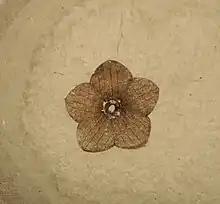 | |
| Florissantia quilchenensis Klondike Mountain Formation | |
| Scientific classification | |
| Kingdom: | Plantae |
| Clade: | Tracheophytes |
| Clade: | Angiosperms |
| Clade: | Eudicots |
| Clade: | Rosids |
| Order: | Malvales |
| Family: | Malvaceae |
| Subfamily: | Sterculioideae |
| Genus: | †Florissantia (Knowlton) Manchester |
| Species | |
| |
| Synonyms[1][2] | |
|
F. ashwillii synonymy
F. quilchenensis synonymy
F. sikhote-alinensis synonymy
F. speirii synonymy
| |
Distribution
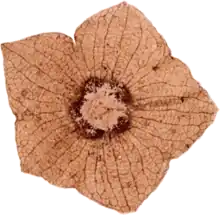
Fossils of Florissantia have been found in Early Eocene to Middle Oligocene localities, including fossil beds in Alaska,[3] British Columbia, Colorado, Montana, Oregon, Utah, Washington, Wyoming[1] and the Russian far east.[2]
The type species F. speirii is known from a number of formations in the west, with the type locality being the Florissant Formation of Colorado. The formation is composed of successive lake deposits resulting from a volcanic debris flow damming a valley. When the species was described, the Florissant Formation was considered to be Miocene in age, based on the flora and fauna preserved.[4][5] Successive research and fossil descriptions moved the age older and by 1985 the formation had been reassigned to an Oligocene age.[6] Further refinement of the formation's age using radiometric dating of sanidine crystals has resulted in an age of 34.07 million years ago placing the formation in the Priabonian stage of the Late Eocene.[7][8] A tentative report of the species from the Katalla Formation, Alaska was made by Jack Wolfe (1977) based on a single specimen.[3]
F. quilchenensis has been recovered from four locations in the Okanagan highlands, the Falklands and McAbee sites[9] near Cache Creek, British Columbia, the Coldwater Beds Quilchena site near Quilchena, British Columbia and the Klondike Mountain Formation in Republic, Washington, northern Ferry County, Washington.[10][1] The Okanagan highlands are aged between 51.5 ± 0.4 million years ago for the Quilchena site to 51.2 to 49.4 million years ago for the Klondike Mountain Formations Tom Thumb Tuff member.[11] The youngest F. quilchenensis occurrence is from the early Oligocene Gumboot Mountain Flora of southwestern Washington.[12] Additionally Florissantia sp. fossils have also been reported from Okanagan highlands sites in the Allenby Formation near Princeton, the Horsefly Shales near Horsefly, and the Driftwood Shales near Smithers, British Columbia, without indication of specie affinity.[9]
F. ashwillii is confined to the Middle to Late Eocene Clarno Formation, Latest Eocene Goshen flora and Early Oligocene John Day Formation of central Oregon. The type locality was designated by Manchester (1992) as the Sheep Rock Creek locality, which represents an isolated pond deposit likely correlating to Clarno Formation based on a palm frond fossil found at the site. The species also is present in the western Oregon "Goshen Flora", which is part of the Fisher Formation[13] The youngest occurrences of F. ashwillii are confined to the Summer Spring shales locality around Grey Butte and thought to correlate with Early Oligocene strata of the John Day Formation.[1]
The Amgu flora, the type locality for F. sikhote-alinensis, represents outcrops of the Khutsin Formation exposed in the Sikhote Alin mountains on the Russian far-east coast. The flora was reported by Manchester (1999) as Miocene, however more detailed work on the stratigraphy of the region moved the age to Early Oligocene as noted by Kvaček et al (2005),[14] Peng et al (2011) reported a slightly older late Eocene or Early Oligocene age[15] which was followed by Archibald and Rasnitsyn (2018) who list the site as likely Priabonian or perhaps Rupelian.[16]
History & classification
Fossils now placed in Florissantia were first reported by Leo Lesquereux (1883) from the Florissant Formation and described as the morning glory family species Porana speirii. Additional fossils were described by Knowlton (1916) as another species, Porana similis as well as a third species, which he placed into the new genus Florissantia as Florissantia physalis.[1]
Calyxes of F. quilchenensis were first reported by Berry (1929), who identified them as the Miocene Hydrangea species Hydrangea bendirei. The Republic fossils were later included by Brown (1935) in Porana speiri. Mathewes and Brooke (1971) described a solitary flower as the new species Holmskioldia quilchenensis from a fossil found at the Quilchena site in British Columbia,[17] which Manchester (1992) redescribed based on a larger selection of specimens from Republic, and moved the species into Florissantia.[1]
The first instance of F. ashwillii was published by Chaney and Sanborn (1933) who included the flowers as in their species Viburnum palmatum. Manchester (1992) described the Florissantia species based on a series of 45 fossils found in north central Oregon and noted that the 1933 flower was not related to the leaf holotype fossil of V. palmatum. The F. ashwillii holotype specimen, UF 11740, was a part of the University of Florida collections at the time of description, with additional fossils examined from the University of California Museum of Paleontology collections. Manchester chose the specific epithet ashwillii as a patronym honoring Melvin S. Ashwill who collected many of the specimens examined.[1]
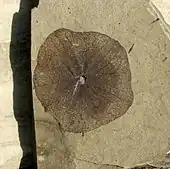
Description
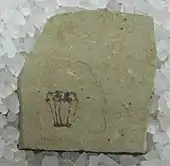
All Florissantia species share a distinct set of physical traits in common. The flowers are radially symmetrical shallowly bell shaped, with large sepals fused up to 50% of their length and born on long pedicels. The sepals display a distinct reticulate venation radiating from the center of each sepal with the crossveins forming rectangular to polygonal meshes of smaller veins. Between five and seven major veins run from the sepal base apically before loping towards the apex and fusing together. Additional large veins run to the point of each sinus, and supporting several secondary veins. The basal calyx is thicker than the sepal tissue and often hairy with the small thick petals forming a corolla around the calyx base. The flowers have an expanded androgynophore from which the ovary arises. A single style extends from the center of the ovary though the surrounding androecium to above the corolla of five stamens. The stamen filaments fork once near the tip, and host ten total anthers with elongated to globose outlines. The 20–32 μm (0.00079–0.00126 in) pollen grains are slightly flattened spheres, with three to four short colpi apertures on the outer surface[1]
Florissantia ashwillii
Florissantia ashwillii calyxes are moderate in size with a diameter of 21–31 mm (0.83–1.22 in), those of F. quichenensis are known to be smaller, while those of F. speirii range notably larger. F. ashwilli is noted for having deeply indented lobe sinuses which extend between 35% to 60% towards the center of the corolla from the margins. The pedicels are at least 13 mm (0.51 in) long, with a hairy basal area of the corolla, and pollen smaller than that of F. speirii.[1]
Florissantia quilchenensis
F. quilchenensis is calyxes range between 19–33 mm (0.75–1.30 in), with some of the smallest recorded specimens in Florissantia. unlike the other three species, the calyx lobes range from approximately 33% indentation to being fully absent, resulting in a circular calyx. At the time of description, only three specimens had been recovered in which the stamens were present and approximately ten anthers or half anthers are preserved on the most complete of the specimens. The pedicels are longer than those in F. ashwillii, being between 16–21 mm (0.63–0.83 in) long and 0.5–0.7 mm (0.020–0.028 in) thick. The petals are around 3.0 mm × 3.5 mm (0.12 in × 0.14 in) and are arranged in alternation with the Calyx lobes, when the lobes are present. The style is 8 mm (0.31 in) long and extends above the stamens. Rather than having globose anthers, such as seen in F. speirii, the 2–3 mm (0.079–0.118 in) long anthers are elongated like those seen in F. ashwillii.[1]
Florissantia sikhote-alinensis
Florissantia sikhote-alinensis was first described as Porana by Kryshtofov (1921). The fossil pictured in plate 2 fig. 7 of the paper was subsequently lost and was unavailable for reexamination by Manchester in 1998.[2]
Florissantia speirii
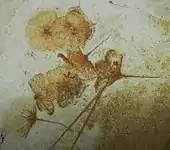
F. speirii calyxes range between 23–54 mm (0.91–2.13 in) having some of the largest calyxes in Florissantia. The calyxes show poorly developed to well developed lobes that indent between 20%–35% from the outer margins and in flowers with poorly developed indentation, the calyx outline is pentagonal instead of rounded.[1] The androgynophore has a rounded pentagonal to circular cross-section and an approximately 11 mm (0.4 in) long style.
A tepal corolla has been found attached to a single fossil from the Florissant Fossil Beds National Monument collections.[18]
Paleoecology
The structure of Florissantia flowers suggests the genus was pollinated by insects or birds. With the long slender pedicels, the flowers likely hung downwards from the plant in an pendant like manner, with dense hairs along the flower bases acting as nectaries.[1] These are features seen in a number of modern Malvaceae genera. Additionally the stamens and styles are thicker and robust, features often associated with bird and bat pollinators, indicating Florissantia may have been a transitional genus between insect pollination and bat or bird pollination.[1] It is possible the caylxes did not grow to full size until after pollination, with the young flowers being smaller and less showy. It is likely the fruits matured into a samara with the calyx acting as a wing around the fruit.[1]
References
- Manchester, S.R. (1992). "Flowers, fruits and pollen of Florissantia, an extinct malvalean genus from the Eocene and Oligocene of western North America". American Journal of Botany. 79 (9): 996–1008. doi:10.2307/2444909. JSTOR 2444909.
- Manchester, S. R. (1999). "Biogeographical relationships of North American tertiary floras". Annals of the Missouri Botanical Garden. 86 (2): 472–522. doi:10.2307/2666183. JSTOR 2666183.
- Wolfe, J.A. (1977). Paleogene floras from the Gulf of Alaska region (Report). Professional Paper. Vol. 997. United States Geological Survey. pp. 1–108. doi:10.3133/pp997.
- Scudder, S. H. (1890). "The Tertiary insects of North America". United States Geological Survey of the Territories, Washington: 615. ISBN 9780665263149.
- Carpenter, F. M. (1930). "The fossil ants of North America" (PDF). Bulletin of the Museum of Comparative Zoology. 70: 1–66.
- Tindale, N. B. (1985). "A butterfly-moth (Lepidoptera:Castniidae) form the Oligocene shales of Florissant, Colorado" (PDF). Journal of Research on the Lepidoptera. 24 (1): 31–40. doi:10.5962/p.266764. S2CID 109301568.
- Ksepka, D.T.; Clarke, J.A. (2009). "Affinities of Palaeospiza bella and the Phylogeny and Biogeography of Mousebirds (Coliiformes)". The Auk. The American Ornithologists' Union. 126 (2): 245–259. doi:10.1525/auk.2009.07178. S2CID 85597698.
- Lloyd, K.J.; Eberle, J.J. (2008). "A New Talpid from the Late Eocene of North America". Acta Palaeontologica Polonica. Institute of Paleobiology, Polish Academy of Sciences. 53 (3): 539–543. doi:10.4202/app.2008.0311.
- Dillhoff, R.M.; Leopold, E.; Manchester, S. (2005). "The McAbee flora of British Columbia and its relations to the Early-Middle Eocene Okanagan Highlands flora of the Pacific Northwest" (PDF). Canadian Journal of Earth Sciences. 42 (2): 151–166. Bibcode:2005CaJES..42..151D. doi:10.1139/e04-084.
- Wolfe, J.A.; Wehr, W.C. (1987). Middle Eocene dicotyledonous plants from Republic, northeastern Washington (Report). Bulletin. Vol. 1597. United States Geological Survey. pp. 1–25. doi:10.3133/b1597.
- Rubino, E.; Leier, A.; Cassel, E.; Archibald, S.; Foster-Baril, Z.; Barbeau, D. Jr (2021). "Detrital zircon UPb ages and Hf-isotopes from Eocene intermontane basin deposits of the southern Canadian Cordillera". Sedimentary Geology. 105969 (online).
- Wehr, W.C. (1995). "Early Tertiary flowers, fruits and seeds of Washington State and adjacent areas". Washington Geology. 23 (3): 3–16.
- Myers, J.A.; Kester, P.R.; Retallack, G.J.; Moore, G.W. (2002). "Paleobotanical record of Eocene-Oligocene climate and vegetational change near Eugene, Oregon". Field guide to geological processes in Cascadia. Vol. 36. Oregon Department of Geology and Mineral Industries Special Paper. pp. 15–54.
- Kvaček, Z.; Manchester, S. R.; Akhmetiev, M. A. (2005). "Review of the fossil history of Craigia (Malvaceae sl) in the Northern Hemisphere based on fruits and co-occurring foliage". Transactions of the International Palaeobotanical Conference. 1: 114–140.
- Peng, Y.; Makarkin, V.N.; Wang, X.; Ren, D. (2011). "A new fossil silky lacewing genus (Neuroptera, Psychopsidae) from the Early Cretaceous Yixian Formation of China". ZooKeys (130): 217–228. doi:10.3897/zookeys.130.1576. PMC 3260761. PMID 22259278.
- Archibald, S. B.; Rasnitsyn, A. P. (2018). "Two new species of fossil Eomerope (Mecoptera: Eomeropidae) from the Ypresian Okanagan Highlands, far-western North America, and Eocene Holarctic dispersal of the genus". The Canadian Entomologist. 150 (3): 393–403. doi:10.4039/tce.2018.13. S2CID 90119028.
- Mathewes, R.; Brooke, R. (1971). "Fossil Taxodiaceae and new angiosperm macrofossils from Quilchena, British Columbia". Syesis. 4: 209–216.
- Manchester, S.R. (2001). "Update on the megafossil flora of Florissant, Colorado in Fossil flora and stratigraphy of the Florissant Formation, Colorado". Proceedings of the Denver Museum of Nature and Science, Series. 4: 137–162.
External links
 Media related to Florissantia at Wikimedia Commons
Media related to Florissantia at Wikimedia Commons